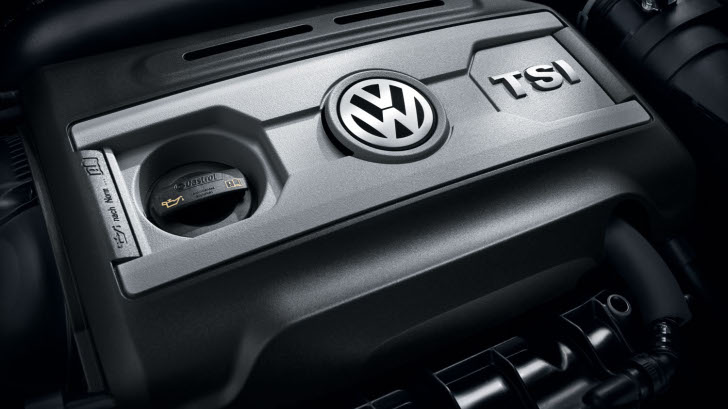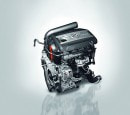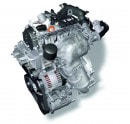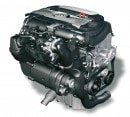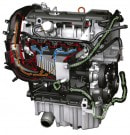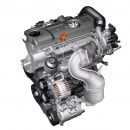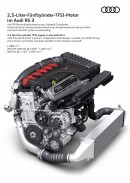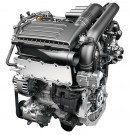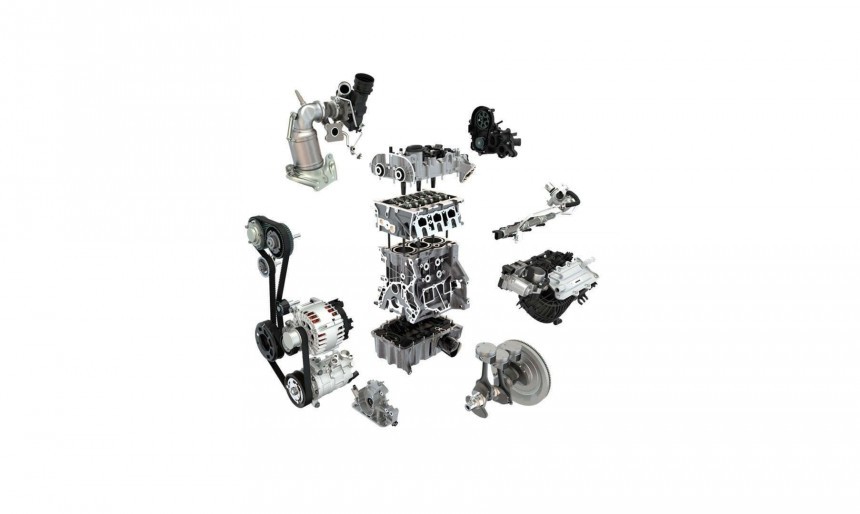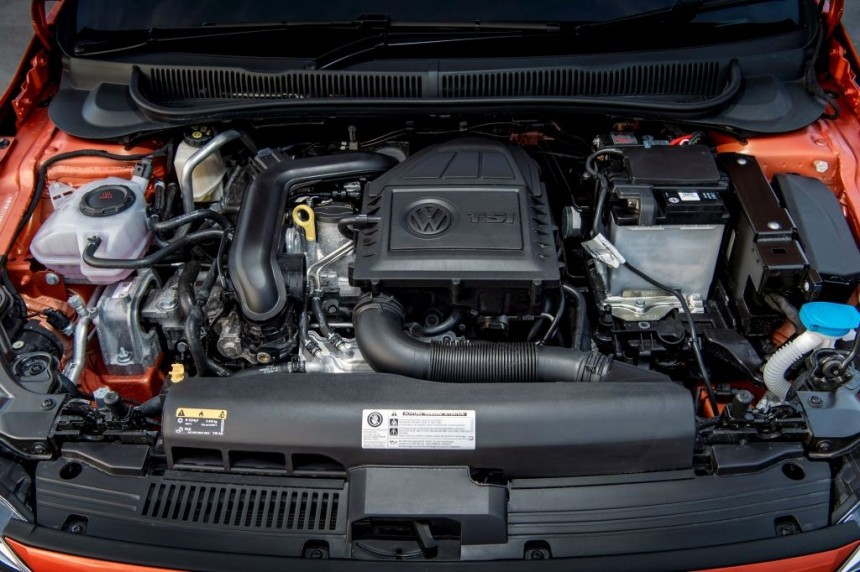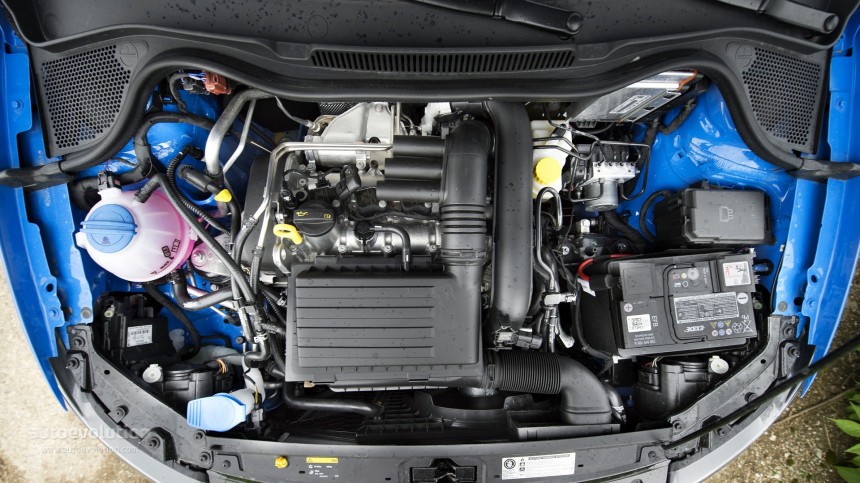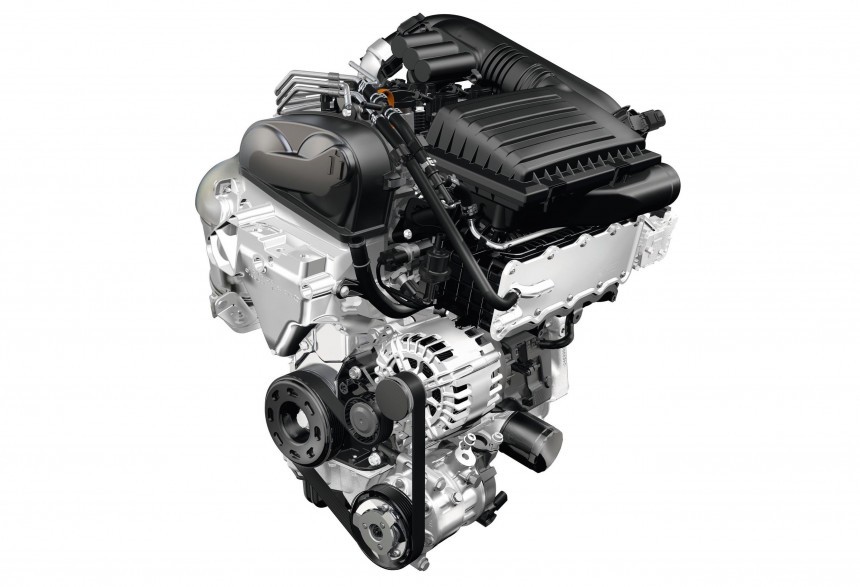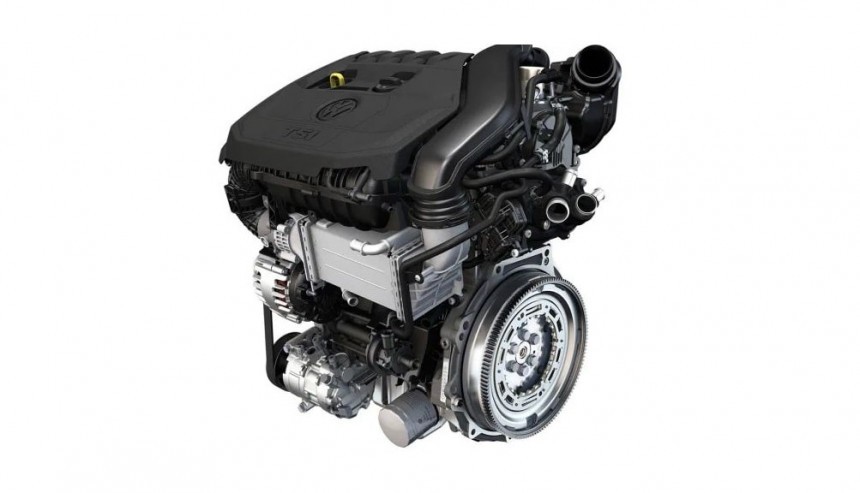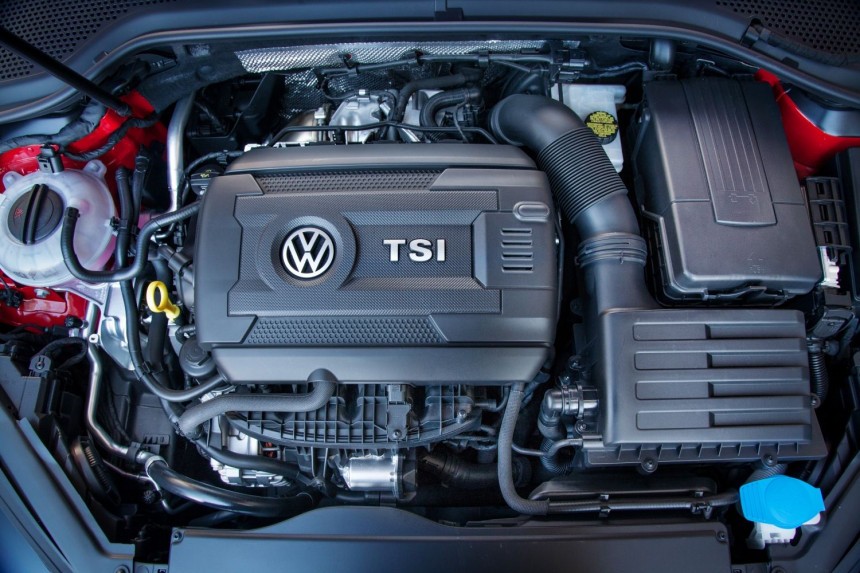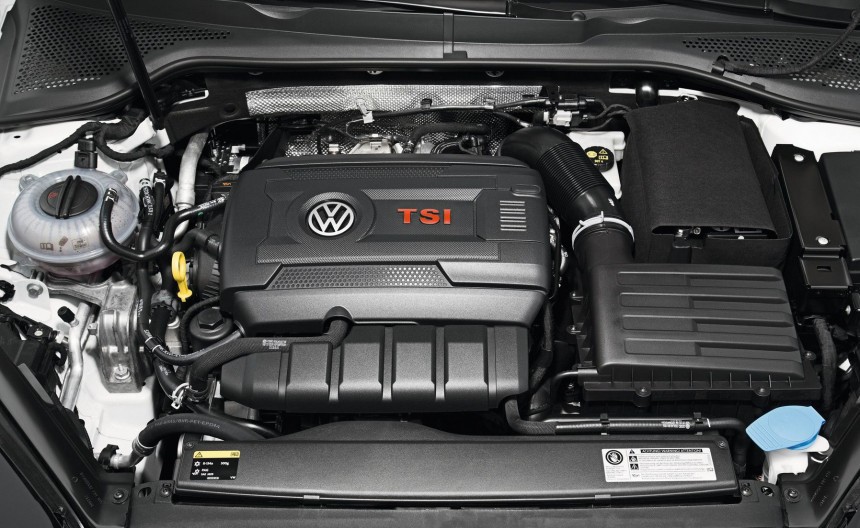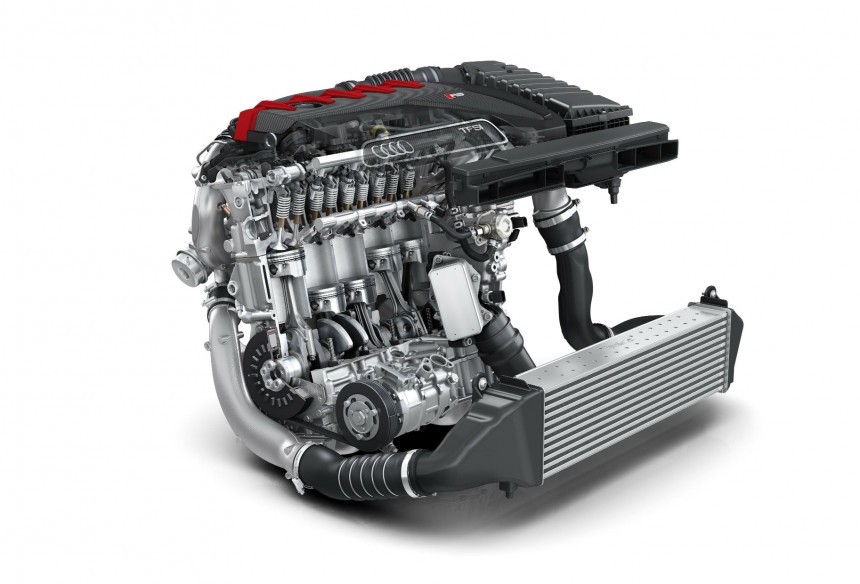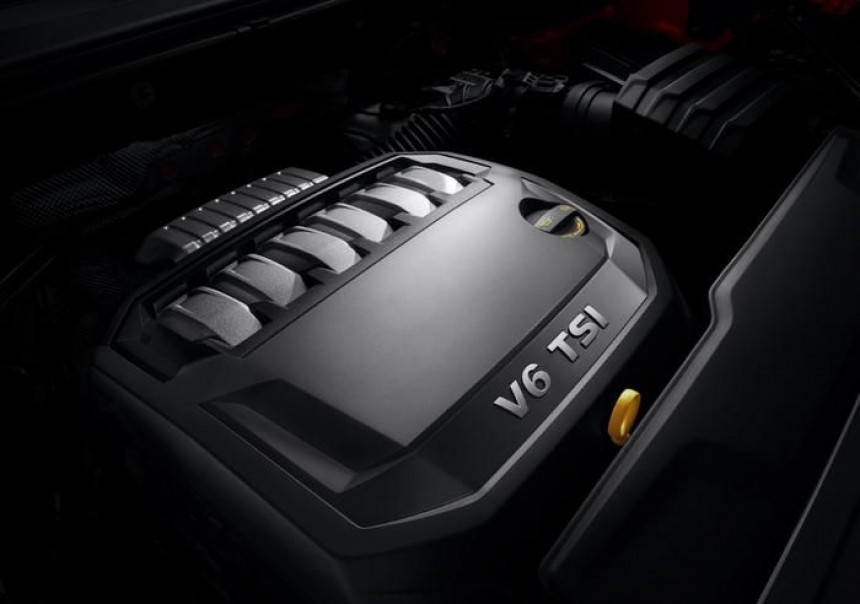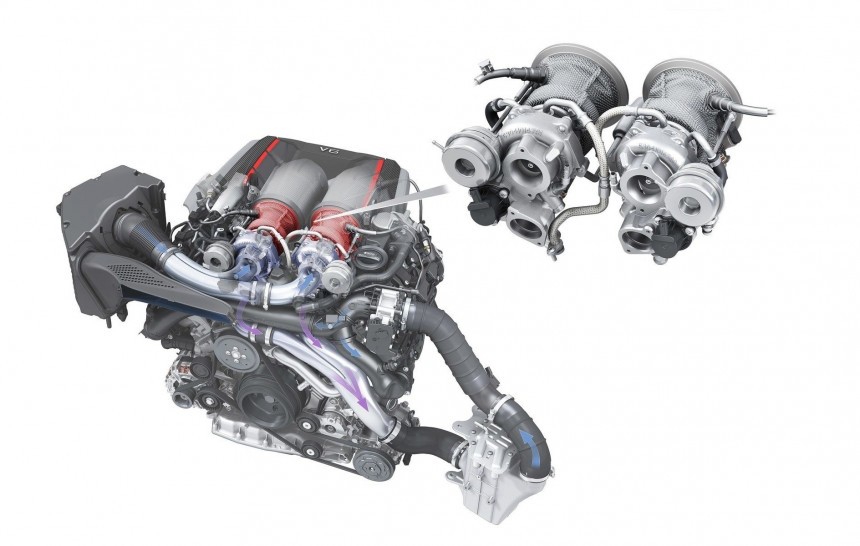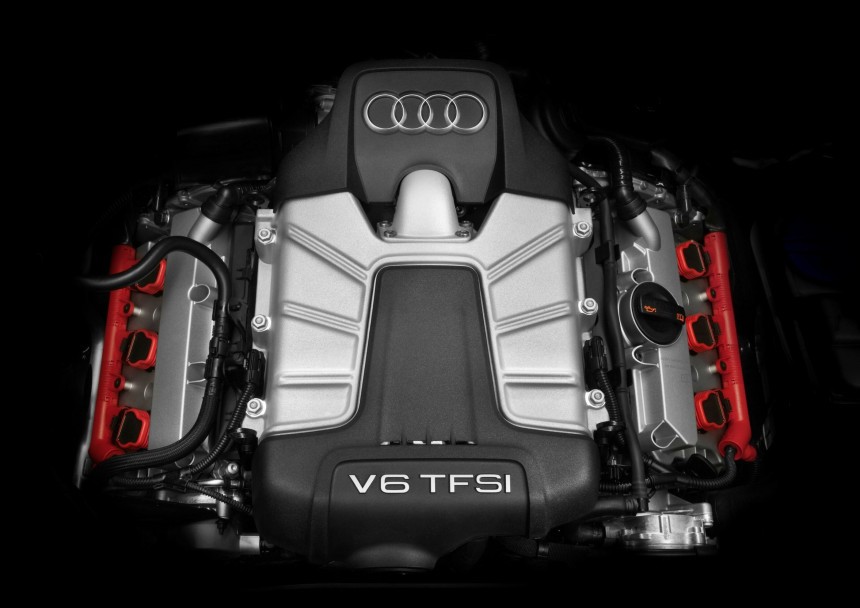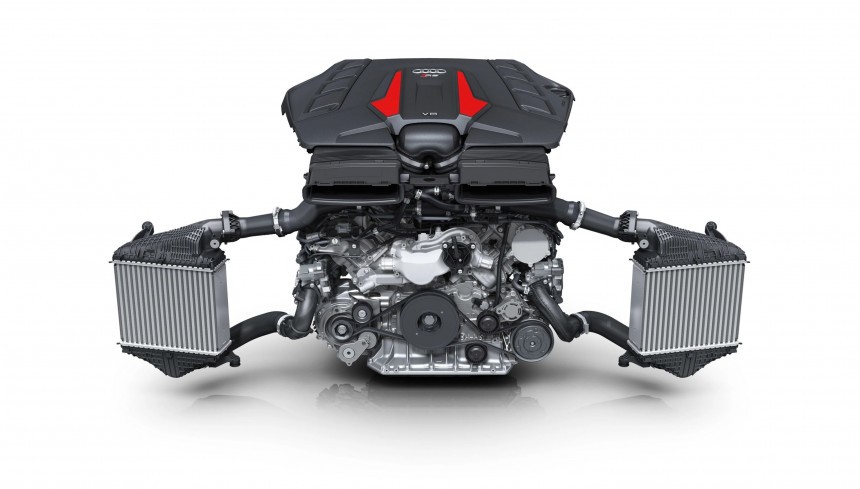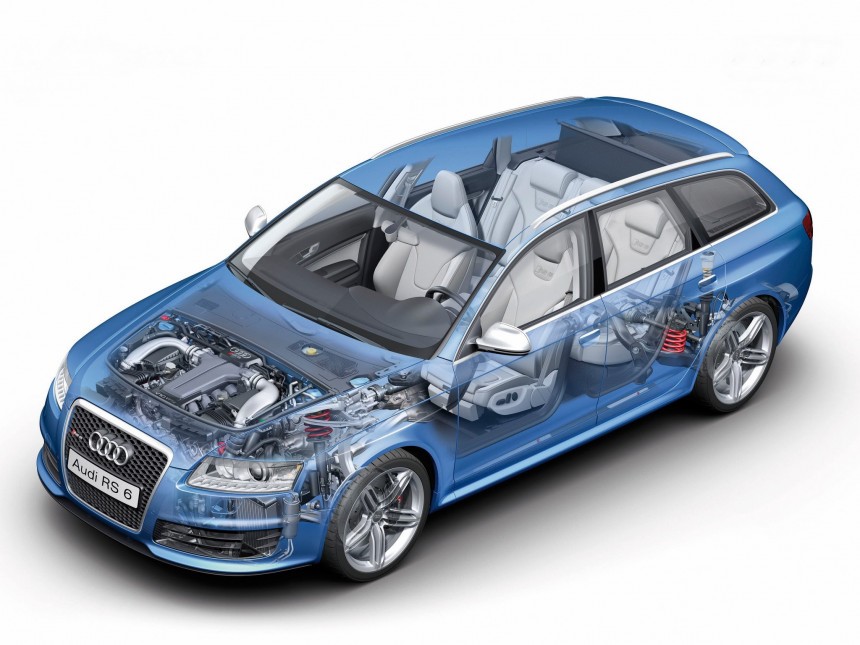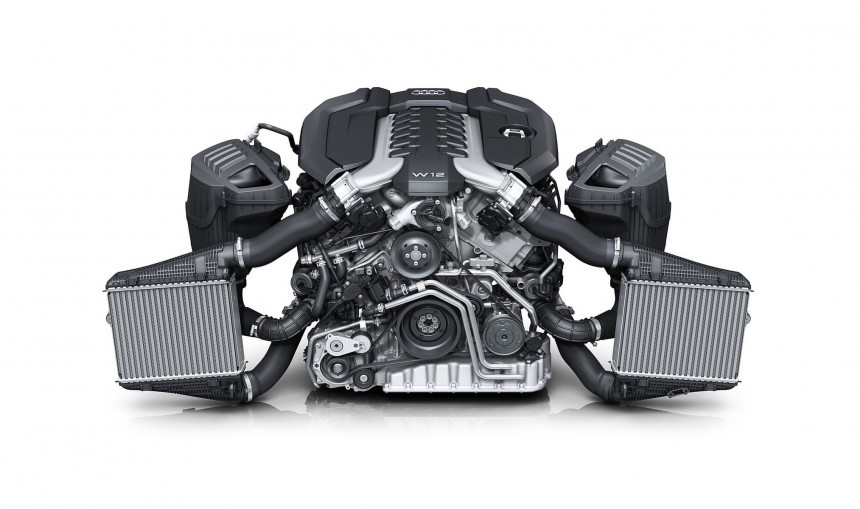The Volkswagen Group is the second-largest automaker in the world by sales, moving 9.24 million vehicles in 2023. Even though everyone and their dog wants a hybrid or an EV nowadays, most of those 9.24 million vehicles were specified with TSI engines, with TSI being the short way of saying Turbocharged Stratified Injection.
Volkswagen's first-ever TSI engines rolled out nearly two decades ago with the Mk5 Golf GTI's 2.0 T-FSI and the GT's 1.4 TSI. The latter combines an exhaust-gas turbocharger with a supercharger, a combo that would be dropped by the German automaker due to advancements in turbocharging technology.
Before going any further, what does the stratified injection part actually mean? Officially designated FSI, stratified injection is Volkswagen jargon for direct injection. It's the very same thing as the Audi brand's TFSI technology. Speaking of which, the first-ever TFSI is the 2.0-liter unit launched in the Audi A3 series back in the summer of 2004.
Used across the group's most famous automotive brands, TSI and TFSI powerplants offer pretty clear benefits over engines with multi-point injection. To put it simply, more torque is available from much lower revs, with said peak torque maintained across a wider engine speed range. This makes cars, crossovers, vans, and trucks equipped with these engines livelier at lower revolutions per minute, that bit cleaner, and more efficient to boot.
By injecting fuel directly into each cylinder's combustion chamber, direct injection minimizes pumping losses and levels up combustion efficiency over port-injected engines. Newer TSI and TFSI engines combine direct and port fuel injection because said technologies have their minuses. Combining two injection systems may sound a bit complex, but still, TSI and MPI tech in one engine diminishes each other's negatives.
Even newer TSI and TFSI lumps come with mild-hybrid assistance in the form of a belt-driven starter generator and a 48-volt battery. Volkswagen automobiles with mild-hybrid engines are marketed as eTSI, whereas the Skoda brand uses e-TEC.
Having covered all the basics, the time is right for us to dig a little deeper into the TSI and – by extension – the TFSI engine families. To keep this piece nice and clean, we'll kick it off with the smallest member of the regnum, then work our way up to Bentley's trademark 6.0L twin-turbo W12.
A single liter, three cylinders, and lots of applications. The 1.0 TSI and TFSI are both EA211 engines, with the EA211 series entering series production back in 2012 with four cylinders and 1.2 or 1.4 liters of displacement. Skoda's main plant in Mlada Boleslav is tasked with series production of the group's EA211s three- and four-pot mills.
The Czech automaker is also tasked with future-proofing said engines, which can be found in vehicles ranging between the A and D segments. Think Skoda Citigo for the 1.0-liter TSI all the way to the Volkswagen Passat for the 1.4-liter TSI.
The B9 switched to EA211 1.5 TSI and the EA888 2.0 TSI, but more on those powerplants later. At press time, Volkswagen's punchiest 1.0-liter engine for the UK and European markets is rated at 116 pferdstarke (114 horsepower) and 200 Nm (148 pound-feet). The eTSI's lightweight electric motor briefly assists with torque when moving off.
Obviously lighter than the 1.4-liter TSI from which it's derived, the 1.2-liter TSI replaced the naturally aspirated 1.6-liter FSI. Notable applications include the Polo, Golf, Caddy, Fabia, Yeti, Rapid, Ibiza, Leon, Toledo, and A1. The EA111-series engine was launched in the Mk6 Golf and the Mk5 Polo.
Identification codes for the EA211-series 1.2 TSI include CJZB and CYVA (both rated at 84 horsepower), CJZC and CYVA (89 horsepower), CJZA (103 horsepower), as well as CYVB and CJZD (both crank out 109 horsepower at 1,400 to 4,000 revolutions per minute). Considering the 1.0-liter engine's current peak output figures, the plucky three-cylinder mill indirectly replaces the four-pot 1.2er in the group's current range of models.
Q6 what now? As opposed to the Q6 e-tron electric sport utility vehicle, Q6 without e-tron means full-size luxury crossover with either four- or six-cylinder turbocharged mills. Revealed in 2022, the Q6 is manufactured by the Sino-German joint venture SAIC Audi. Nearly 5.1 meters long, the Q6 stretches over 2,980 millimeters (117.3 inches) in terms of wheelbase, which puts it in the same category as the Volkswagen Teramont/Atlas.
The Jetta for North America was once powered by the 1.4-liter TSI. For the 2022 model year, the compact sedan changed to the 1.5-liter TSI we'll talk about in a moment. Instead of the lesser engine's 147 peak horsepower rating, the 2022-and-newer Jetta's 1.5 TSI makes 158 horsepower.
The 1.5er is the first member of the EA211 evo family. It serves as the successor to the 1.4-liter TSI, and in stark contrast to its forerunner, it's a Miller-cycle engine. Patented in December 1957 by American engineer Ralph Miller, the Miller cycle is a development of the Atkinson cycle.
Revealed at the 37th Vienna Motor Symposium, this engine launched with initial output of 96 and 110 kilowatts, meaning 131 and 150 European steeds or 129 and 148 American broncos. The 1.5-liter TSI evo2 launched in 2022 with little in the way of changes over the original, beginning with the integration of the catalytic converter and gasoline particulate filter into a single module.
ACTplus is another highlight, for it promises a smoother changeover from four- to two-cylinder mode at low and medium loads. Similar to the original, the evo2 features a variable-geometry turbocharger to minimize lag at low RPMs and for uncompromised performance at high RPMs.
In early 2007, the EA888 1.8 TFSI was launched by Ingolstadt's favorite son with a crank estimate of 118 kilowatts/160 metric horsepower/158 mechanical horsepower. Torque? For the CDAA, the advertised estimate is 250 Nm or 184 pound-feet at 1,500 to 4,500 revolutions per minute.
The EA888-series engine is built around a cast-iron block. The Gen 2 builds on the firstborn with a new crankshaft with redesigned main journals, pistons, and piston rings. Audi made a lot of changes for the Gen 3, especially when it comes to the valvetrain. The Volkswagen Passat for North America used third-gen 1.8s, namely the CPKA and CPRA.
In the 2014 to 2017 model year NMS Passat, said 1.8-liter TSI developed 170 horsepower and 184 pound-feet (249 Nm) of torque. By comparison, the American Passat's older naturally aspirated 2.5-liter MPI five-cylinder engine developed 170 horsepower and 177 pound-feet (240 Nm).
Closely related to the aforementioned 1.8 TSI, the 2.0 TSI prevailed as the more popular engine. Both feature an 82.5-millimeter bore size, whereas the stroke length ranges from 84.1 to 92.8 millimeters. In other words, the 1.8 is a square design as opposed to an undersquare design for the 2.0er.
The Atlas three-row crossover and the better-looking Atlas Cross Sport come with the 2.0-liter engine by default for the 2024 model year, with Volkswagen dropping the good ol' VR6 in favor of this four-cylinder turbocharged lump. It develops a hugely respectable 269 horsepower and 273 pound-feet (370 Nm) on premium dinosaur juice.
Be that as it may, the most powerful and torquiest EA888 in production today is that of the S3. The Audi brand's take on the Volkswagen Golf R cranks out 328 horsepower and 310 pound-feet (420 Nm) versus 296 and 295 (400) for the Golf R.
Audi made a name for itself with the five-cylinder mills of the retro-tastic Quattro. Developed by Audi Sport GmbH back when it was called quattro GmbH, the EA855 is the spiritual heir of the monster that helped Audi secure two WRC manufacturer titles during the Group B era.
New V6 engines gradually replaced the original fivers in the 1990s, only for Audi to revive the glorious five-cylinder turbo in 2009 with direct injection. Premiered at the 2009 Geneva Motor Show, the TT RS introduced this engine with a DIN-rated 250 kW (350 ps/335 hp) and 450 Nm (332 lb-ft) from 1,600 all the way to 5,300 revolutions per minute.
Taking inspiration from TDI engines, the block of the 2,480-cc fiver is made from compacted vermicular graphite cast iron. The Cupra Formentor VZ5 crossover also uses Audi Sport's five-cylinder turbo, and the same can be said about certain versions of the KTM X-Bow open two-seater speedster.
Believe it or not, Volkswagen still makes a VR6 engine. However, the 2.5-liter TSI is the very definition of a forbidden fruit because it's a China-only affair. Remember the Audi Q6? That fellow comes with the 2.0-liter EA888 as standard, but its range-topping engine is the 2.5-liter EA390.
Derived from the naturally aspirated 3.6-liter VR6 of the Atlas, the turbocharged 2.5-liter VR6 is advertised in the Middle Kingdom with peak output ratings of 220 kW (299 ps / 295 hp) and 500 Nm (369 pound-feet). Audi China refers to it as 50 TFSI, while Volkswagen China dubs it 530TSI. Volkswagen's only applications are the Q6-twinned Talagon, Teramont, and the Teramont X.
In June 2023, the folks at HPA Motorsports of Langley Township, Canada unleashed a 2.5-liter VR6 turbo with 550 ponies and 550 pound-feet (746 Nm) of torque on deck. Said engine is reserved for 50 units of the Mk7.5 Golf R. Including labor, the transplant retails at just under $40,000.
Just like the EA888 and EA211, the EA839 comes in distinct flavors. The 2.9-liter TFSI is a twin-turbo engine, whereas the 3.0-liter TFSI uses a single turbocharger. As you might have guessed by now, the 2.9er is the high-performance motor.
The 84.5-millimeter bore is shared, but stroke varies from 86 to 89 millimeters, therefore resulting in two undersquare designs. Aluminum-silicon alloy is used for the cylinder block, while the cylinder heads are made from aluminum alloy. Both the 2.9- and 3.0-liter engines are hot Vs, meaning that the turbocharger/turbochargers are located in the valley between the heads.
The Audi RS 4 and RS 5, the Porsche Panamera and Panamera 4, and the Bentley Flying Spur Hybrid rock the 2.9 TFSI, with declared output figures topping 346 kW (470 ps/464 hp) and 600 Nm (443 lb-ft) in the RS 4 Avant Edition 25 Years and RS 5 Sportback Edition 25 Years. The most powerful six-cylinder Audi Sport vehicles of 2024 are limited to 250 units each in the Old Continent.
The 3.0 TFSI may not be as potent as the 2.9 TFSI, but looking at the glass half full, it gets the job done. This engine was designed for vehicles based on the Volkswagen Group's MLB platform, with said vehicles ranging from the Audi A4 to the Volkswagen Touareg and Bentley Bentayga Hybrid. Similar to the 2.9-liter Flying Spur Hybrid, the 3.0-liter Bentayga Hybrid is a plug-in hybrid.
The 971-series Panamera and Panamera 4 also flaunt said engine, which is good for 243 kW (330 ps/325 hp) and 450 Nm (331 lb-ft) from 1,800 to 5,000 revolutions per minute. As for the most exciting tune so far, that would be the 3.0-liter TFSI of the Audi S4 and S5 for North America.
349 horsepower and 369 pound-feet (500 Nm) from a single-turbo sixer is pretty good, but not good enough. The 3.0-liter TFSI in the S4 and S5 play second fiddle to Ford's 3.0-liter EcoBoost, which is a twin-turbo V6 with up to 418 horsepower and 440 pound-feet (597 Nm) in the Bronco Raptor.
The 4.0 TFSI powers a helluva lot of high-performance cars and sport utility vehicles produced by the Volkswagen Group. It all started with the Audi-developed EA824 in 2011, a hot-V engine that was replaced by the EA825 series.
According to a self-study program on the EA825 series, Audi notes the following changes: improved fuel injection system, reduced engine friction, a new cooling module, improved responsiveness, better fuel economy, and better output numbers. The most powerful applications of the 4.0-liter TFSI are the Urus S and Urus Performante, which make 666 metric ponies or 657 horsepower.
Both of them have been replaced by the Lamborghini Urus SE plug-in hybrid, whose internal combustion engine is rated at 620 ps (611 hp). Back in May 2024, the Huracan's plug-in hybrid V8 successor was confirmed by Lamborghini's big kahuna with a 4.0-liter engine that revs higher than any EA825-series 4.0 TFSI. The 10,000-rpm thriller puts out 800 ps (789 hp). At the moment of writing, it's not known whether this V8 is derived from the 4.0 TFSI or not.
The 5.0 TFSI, meanwhile, was an Audi-exclusive engine based on the pre-facelift Gallardo's naturally aspirated 5.0-liter V10. It was used by a single model in Audi's lineup, namely the C6-generation RS 6. This generation of the RS 6 came in four-door sedan and five-door station wagon body styles, with production taking place at the Neckarsulm plant from December 2007 through August 2010.
Approximately 8,000 units were assembled, of which around 6,500 were longroofs. Emphasis on were because 571 horsepower and 480 pound-feet (650 Nm) can get you in trouble real fast. Even if the Torsen center differential features a default torque split of 40 percent fore and 60 percent aft, it's a nose-heavy car that can bite real hard.
The first-gen Continental GT and GTC launched with 560 ps (552 hp) and 650 Nm (479 lb-ft), whereas the second generation flexed 575 ps (567 hp) and 700 Nm (516 lb-ft). Codenamed EA398, said powerhouse was replaced by the 6.0-liter TFSI in late 2015 in the 2016 model year Bentley Bentayga. The fourth-generation Audi A8 also received this engine, but word has it that only a small number of A8 L W12 luxury sedans were made. The easiest way of telling the EA398 apart from the 6.0-liter TFSI is displacement in cubic centimeters, namely 5,998 and 5,950 cubes, respectively.
Handcrafted at Bentley's Dream Factory in Crewe, the iconic W12 was discontinued in April 2024. Over 100,000 examples of the breed were produced, with the most exciting iteration being the Mulliner Batur's engine: 750 metric ponies (740 horsepower) and 1,000 Nm (738 pound-feet). A plug-in hybrid V8 setup dubbed Ultra Performance Hybrid succeeds the 6.0 TFSI, with Bentley confirming a total output of 782 pferdestarke (771 horsepower) and 1,000 Newton meters.
Before going any further, what does the stratified injection part actually mean? Officially designated FSI, stratified injection is Volkswagen jargon for direct injection. It's the very same thing as the Audi brand's TFSI technology. Speaking of which, the first-ever TFSI is the 2.0-liter unit launched in the Audi A3 series back in the summer of 2004.
Used across the group's most famous automotive brands, TSI and TFSI powerplants offer pretty clear benefits over engines with multi-point injection. To put it simply, more torque is available from much lower revs, with said peak torque maintained across a wider engine speed range. This makes cars, crossovers, vans, and trucks equipped with these engines livelier at lower revolutions per minute, that bit cleaner, and more efficient to boot.
Even newer TSI and TFSI lumps come with mild-hybrid assistance in the form of a belt-driven starter generator and a 48-volt battery. Volkswagen automobiles with mild-hybrid engines are marketed as eTSI, whereas the Skoda brand uses e-TEC.
Having covered all the basics, the time is right for us to dig a little deeper into the TSI and – by extension – the TFSI engine families. To keep this piece nice and clean, we'll kick it off with the smallest member of the regnum, then work our way up to Bentley's trademark 6.0L twin-turbo W12.
EA211 1.0 TSI and TFSI (launched in 2014)
The Czech automaker is also tasked with future-proofing said engines, which can be found in vehicles ranging between the A and D segments. Think Skoda Citigo for the 1.0-liter TSI all the way to the Volkswagen Passat for the 1.4-liter TSI.
The B9 switched to EA211 1.5 TSI and the EA888 2.0 TSI, but more on those powerplants later. At press time, Volkswagen's punchiest 1.0-liter engine for the UK and European markets is rated at 116 pferdstarke (114 horsepower) and 200 Nm (148 pound-feet). The eTSI's lightweight electric motor briefly assists with torque when moving off.
EA211 1.2 TSI and TFSI (launched in 2012)
Ah, the infamous 1.2er! The EA111-series engine is notorious for a wide array of problems, chief among which is premature timing chain stretching and failure caused by a flakey tensioner. The EA211-series engine is a little better in every respect, although you can find countless horror stories about it on quite a few online forums.Obviously lighter than the 1.4-liter TSI from which it's derived, the 1.2-liter TSI replaced the naturally aspirated 1.6-liter FSI. Notable applications include the Polo, Golf, Caddy, Fabia, Yeti, Rapid, Ibiza, Leon, Toledo, and A1. The EA111-series engine was launched in the Mk6 Golf and the Mk5 Polo.
Identification codes for the EA211-series 1.2 TSI include CJZB and CYVA (both rated at 84 horsepower), CJZC and CYVA (89 horsepower), CJZA (103 horsepower), as well as CYVB and CJZD (both crank out 109 horsepower at 1,400 to 4,000 revolutions per minute). Considering the 1.0-liter engine's current peak output figures, the plucky three-cylinder mill indirectly replaces the four-pot 1.2er in the group's current range of models.
EA211 1.4 TSI and TFSI (launched in 2012)
Not to be confused with the 1.4 TDI three-cylinder turbo diesel, the EA211-series 1.4 TSI and TFSI succeed the EA111-series 1.4 TSI and TFSI. The newcomer was designed exclusively for MQB-based vehicles, with the MQB platform underpinning pretty much everything from the subcompact Polo to the China-only Audi Q6.Q6 what now? As opposed to the Q6 e-tron electric sport utility vehicle, Q6 without e-tron means full-size luxury crossover with either four- or six-cylinder turbocharged mills. Revealed in 2022, the Q6 is manufactured by the Sino-German joint venture SAIC Audi. Nearly 5.1 meters long, the Q6 stretches over 2,980 millimeters (117.3 inches) in terms of wheelbase, which puts it in the same category as the Volkswagen Teramont/Atlas.
The Jetta for North America was once powered by the 1.4-liter TSI. For the 2022 model year, the compact sedan changed to the 1.5-liter TSI we'll talk about in a moment. Instead of the lesser engine's 147 peak horsepower rating, the 2022-and-newer Jetta's 1.5 TSI makes 158 horsepower.
EA211 1.5 TSI and TFSI (launched in 2016)
Revealed at the 37th Vienna Motor Symposium, this engine launched with initial output of 96 and 110 kilowatts, meaning 131 and 150 European steeds or 129 and 148 American broncos. The 1.5-liter TSI evo2 launched in 2022 with little in the way of changes over the original, beginning with the integration of the catalytic converter and gasoline particulate filter into a single module.
ACTplus is another highlight, for it promises a smoother changeover from four- to two-cylinder mode at low and medium loads. Similar to the original, the evo2 features a variable-geometry turbocharger to minimize lag at low RPMs and for uncompromised performance at high RPMs.
EA888 1.8 TSI and TFSI (launched in 2007)
The EA888-series engine is built around a cast-iron block. The Gen 2 builds on the firstborn with a new crankshaft with redesigned main journals, pistons, and piston rings. Audi made a lot of changes for the Gen 3, especially when it comes to the valvetrain. The Volkswagen Passat for North America used third-gen 1.8s, namely the CPKA and CPRA.
In the 2014 to 2017 model year NMS Passat, said 1.8-liter TSI developed 170 horsepower and 184 pound-feet (249 Nm) of torque. By comparison, the American Passat's older naturally aspirated 2.5-liter MPI five-cylinder engine developed 170 horsepower and 177 pound-feet (240 Nm).
EA888 2.0 TSI and TFSI (launched in 2008)
The Atlas three-row crossover and the better-looking Atlas Cross Sport come with the 2.0-liter engine by default for the 2024 model year, with Volkswagen dropping the good ol' VR6 in favor of this four-cylinder turbocharged lump. It develops a hugely respectable 269 horsepower and 273 pound-feet (370 Nm) on premium dinosaur juice.
Be that as it may, the most powerful and torquiest EA888 in production today is that of the S3. The Audi brand's take on the Volkswagen Golf R cranks out 328 horsepower and 310 pound-feet (420 Nm) versus 296 and 295 (400) for the Golf R.
EA855 2.5 TFSI and TSI (launched in 2009)
New V6 engines gradually replaced the original fivers in the 1990s, only for Audi to revive the glorious five-cylinder turbo in 2009 with direct injection. Premiered at the 2009 Geneva Motor Show, the TT RS introduced this engine with a DIN-rated 250 kW (350 ps/335 hp) and 450 Nm (332 lb-ft) from 1,600 all the way to 5,300 revolutions per minute.
Taking inspiration from TDI engines, the block of the 2,480-cc fiver is made from compacted vermicular graphite cast iron. The Cupra Formentor VZ5 crossover also uses Audi Sport's five-cylinder turbo, and the same can be said about certain versions of the KTM X-Bow open two-seater speedster.
EA390 2.5 TSI and TFSI (launched in 2016)
Derived from the naturally aspirated 3.6-liter VR6 of the Atlas, the turbocharged 2.5-liter VR6 is advertised in the Middle Kingdom with peak output ratings of 220 kW (299 ps / 295 hp) and 500 Nm (369 pound-feet). Audi China refers to it as 50 TFSI, while Volkswagen China dubs it 530TSI. Volkswagen's only applications are the Q6-twinned Talagon, Teramont, and the Teramont X.
In June 2023, the folks at HPA Motorsports of Langley Township, Canada unleashed a 2.5-liter VR6 turbo with 550 ponies and 550 pound-feet (746 Nm) of torque on deck. Said engine is reserved for 50 units of the Mk7.5 Golf R. Including labor, the transplant retails at just under $40,000.
EA839 2.9 TFSI (launched in 2016)
The 84.5-millimeter bore is shared, but stroke varies from 86 to 89 millimeters, therefore resulting in two undersquare designs. Aluminum-silicon alloy is used for the cylinder block, while the cylinder heads are made from aluminum alloy. Both the 2.9- and 3.0-liter engines are hot Vs, meaning that the turbocharger/turbochargers are located in the valley between the heads.
The Audi RS 4 and RS 5, the Porsche Panamera and Panamera 4, and the Bentley Flying Spur Hybrid rock the 2.9 TFSI, with declared output figures topping 346 kW (470 ps/464 hp) and 600 Nm (443 lb-ft) in the RS 4 Avant Edition 25 Years and RS 5 Sportback Edition 25 Years. The most powerful six-cylinder Audi Sport vehicles of 2024 are limited to 250 units each in the Old Continent.
EA839 3.0 TFSI and TSI (launched in 2016)
The 971-series Panamera and Panamera 4 also flaunt said engine, which is good for 243 kW (330 ps/325 hp) and 450 Nm (331 lb-ft) from 1,800 to 5,000 revolutions per minute. As for the most exciting tune so far, that would be the 3.0-liter TFSI of the Audi S4 and S5 for North America.
349 horsepower and 369 pound-feet (500 Nm) from a single-turbo sixer is pretty good, but not good enough. The 3.0-liter TFSI in the S4 and S5 play second fiddle to Ford's 3.0-liter EcoBoost, which is a twin-turbo V6 with up to 418 horsepower and 440 pound-feet (597 Nm) in the Bronco Raptor.
EA824 and EA825 4.0 TFSI (launched in 2011)
According to a self-study program on the EA825 series, Audi notes the following changes: improved fuel injection system, reduced engine friction, a new cooling module, improved responsiveness, better fuel economy, and better output numbers. The most powerful applications of the 4.0-liter TFSI are the Urus S and Urus Performante, which make 666 metric ponies or 657 horsepower.
Both of them have been replaced by the Lamborghini Urus SE plug-in hybrid, whose internal combustion engine is rated at 620 ps (611 hp). Back in May 2024, the Huracan's plug-in hybrid V8 successor was confirmed by Lamborghini's big kahuna with a 4.0-liter engine that revs higher than any EA825-series 4.0 TFSI. The 10,000-rpm thriller puts out 800 ps (789 hp). At the moment of writing, it's not known whether this V8 is derived from the 4.0 TFSI or not.
BUH 5.0 TFSI (launched in 2007)
The Gallardo entered production in 2003. Through 2008, it featured a naturally aspirated 5.0-liter V10 with multi-point injection. Presented at the 2008 Geneva Motor Show, the Gallardo LP 560-4 leveled up to a naturally aspirated 5.2-liter V10 with *checks notes* Iniezione Diretta Stratificata. Otherwise put, it's the R8 V10's 5.2-liter FSI.The 5.0 TFSI, meanwhile, was an Audi-exclusive engine based on the pre-facelift Gallardo's naturally aspirated 5.0-liter V10. It was used by a single model in Audi's lineup, namely the C6-generation RS 6. This generation of the RS 6 came in four-door sedan and five-door station wagon body styles, with production taking place at the Neckarsulm plant from December 2007 through August 2010.
Approximately 8,000 units were assembled, of which around 6,500 were longroofs. Emphasis on were because 571 horsepower and 480 pound-feet (650 Nm) can get you in trouble real fast. Even if the Torsen center differential features a default torque split of 40 percent fore and 60 percent aft, it's a nose-heavy car that can bite real hard.
Bentley's 6.0 TFSI (launched in 2015)
What happens when you join two VR6 engines? The answer is a naturally aspirated 6.0-liter colossus that Audi and Volkswagen offered in the A8, Phaeton, and even the Touareg. Usually associated with Bentley, the group's W12 engine gained a couple of snails for the Conti GT and GTC.The first-gen Continental GT and GTC launched with 560 ps (552 hp) and 650 Nm (479 lb-ft), whereas the second generation flexed 575 ps (567 hp) and 700 Nm (516 lb-ft). Codenamed EA398, said powerhouse was replaced by the 6.0-liter TFSI in late 2015 in the 2016 model year Bentley Bentayga. The fourth-generation Audi A8 also received this engine, but word has it that only a small number of A8 L W12 luxury sedans were made. The easiest way of telling the EA398 apart from the 6.0-liter TFSI is displacement in cubic centimeters, namely 5,998 and 5,950 cubes, respectively.
Handcrafted at Bentley's Dream Factory in Crewe, the iconic W12 was discontinued in April 2024. Over 100,000 examples of the breed were produced, with the most exciting iteration being the Mulliner Batur's engine: 750 metric ponies (740 horsepower) and 1,000 Nm (738 pound-feet). A plug-in hybrid V8 setup dubbed Ultra Performance Hybrid succeeds the 6.0 TFSI, with Bentley confirming a total output of 782 pferdestarke (771 horsepower) and 1,000 Newton meters.
